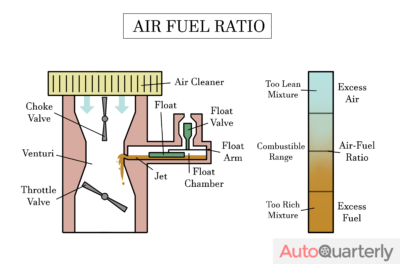Two of the most important ingredients for an engine are air and fuel. In fact, the most significant advances in engine technology—right from the very first internal combustion motor—all have to do with how air and fuel are delivered. Pistons and crankshafts are largely unchanged since the 1800s, but we have come a really long way from the simple carburetor found on Karl Benz’s first four-stroke engines.
The problem is that these modern engines are far more sensitive to improper fuel mixtures, and it can be frustrating trying to figure out why a car is running sub-optimally if the mixture is wrong. In this article, we will look at what the air to fuel ratio is, how it can affect engine performance, and what can cause the issues so that you can correct them.
What Is the Air to Fuel Ratio?
On the intake stroke of your engine, fuel and air are pulled into the cylinder so that they can be compressed and ignited. The efficiency of that ignition dictates how well your motor is running. The better the burn, the more power you will get from each explosion, and the better fuel economy and horsepower you will get.
Stoichiometry
The perfect ratio of fuel to air is 14.7 parts air to 1 part fuel. That’s the ratio of fuel to air that results in the most efficient burn possible, where all of the oxygen and fuel will be consumed. The science of measuring reactions, like the chemical reaction that turns oxygen and fuel into CO 2 and heat, powering your engine, is called stoichiometry.
It’s a big word, and it can sometimes sound shocking to hear a mechanic who refers to an adjustable wrench as a “hammer” say that a motor has a good stoichiometric mixture. It’s important for making power and for a healthy engine, though, so it makes sense, and it’s a good word to learn for impressing your friends.
Just note, though, that in the real world, your car will be happier with around 13:1. We don’t live in perfect atmospheric conditions, so a little bit of extra fuel doesn’t hurt and will still be considered stoichiometric. The science can get really complicated, and there are people on YouTube, like Engineering Explained that do a great job breaking it down if you are interested.
In any case, the real problems start when the ratio is not stoichiometric. There are two possibilities here: not enough fuel or not enough air.
A Rich Mixture
Running rich, sometimes called running fat, happens if you are getting more fuel than you need for a complete burn. In modern cars, usually, this is caused by a lack of adequate air. Unless you have an older carbureted vehicle, it’s unlikely that too much fuel is being added.
A Lean Mixture
The opposite of a rich mixture is called a lean mixture. This is when you have too much air or not enough fuel in the mixture. Lean mixtures are always caused by a lack of sufficient fuel. Air is the biggest limiting factor in generation power, and it is nearly impossible to have too much air accidentally.
Of the two, having a lean mixture is much more dangerous for your engine. An engine can run rich without much issue. An engine running lean can become lubricant starved and seize.
How to Measure the Air to Fuel Ratio

Since the air to fuel ratio is really important, you’d expect there to be a really easy way to measure it. Unfortunately, there’s not. You can calculate it if you know all the variables, see here, but getting the numbers to plug in for each of these variables presents its own challenge.
Fortunately, while you may not be able to get a fully accurate measurement, you can get very close with some alternate methods. These are the three main ways that you can get a good idea of what your mixture is.
1. Use Your 5 Senses
It requires a bit of experience and some trial and error, but you can get a really good idea about whether or not an engine is running efficiently just by using your senses. This method is imprecise, but it’s almost always your first indicator that something is wrong.
An engine that is running too rich will be very noisy, and the exhaust will smell strongly of gas. It will be most noticeable when the engine is idling. You will feel more vibrations from the rough idle, and you will be able to hear the RPMs climb and drop erratically.
By contrast, a car running lean will be running hotter. Sometimes you can smell the sweet, distinct odor of boiling coolant, in which case stop the car and find the problem. Otherwise, what you’ll notice most is that the engine hesitates, and you may hear pinging. A pinging noise as you accelerate is a good indicator that the temperature inside the cylinder is too high, a symptom of running too lean.
2. Read the Plugs
The easiest way to determine if you have the correct fuel mixture is to pull the spark plugs and inspect them. This article from Tuning Matters deals with gas-powered scooters, but the pictures apply to any internal combustion motor.
As you can see in those pictures, a car running too lean will have scored and burned plugs. If the mixture is really bad, a lean burn can actually destroy a spark plug. In contrast, a car running too rich will have fouled plugs that may even be wet with excess fuel when you pull them.
This is not an exact science, but for most applications, it’s good enough.
3. Use Sensors
Modern cars often have a variety of sensors that allow a computer to calculate the air to fuel ratio. There are also specific sensors that you can install on any car to get a real-time readout, but if you have one of those, chances are you don’t need this article—they’re pretty specific tools for people who tune engines.
In order to access that information, you will need an OBD II scan tool. We suggest a few here, but most modern scanners will be able to tell you if an engine is running lean or rich based on the error code it produces. It’s not perfect; the computer only knows that a lean or rich state occurred. It doesn’t know if the problem persisted or what specifically caused the problem. It can give you a good place to start, though.
Running Rich

As mentioned above, a rich mixture is one where there is too much fuel and not enough air. It is a much more common problem in older vehicles that do not have computers constantly adjusting the ratio.
Dangers
There isn’t much risk to a motor that is running a little rich. It’s actually desirable in some circumstances, and many times when someone is tuning a motor, they will err on the side of rich rather than risk running lean.
However, there are still problems that can occur if the issue persists. A rich mixture can cause the catalytic converter and other exhaust components to become fouled and fail. If the catalytic converter fails, it’s very costly to replace. In extreme cases, a clogged exhaust can cause internal engine components to fail, which is even more expensive than replacing the converter.
Symptoms
If you notice the following issues, then it is likely that your car is running rich.
- Excessive fuel consumption
- Rough idle that smooths out as you accelerate
- Strong fuel or rotten egg smell
- Check engine light is on
- The spark plugs have soot on them and/or are wet with excess fuel
- You fail an inspection due to high levels of carbon monoxide
Causes and Solutions
The following are three of the most common causes of a rich mixture and their solutions. This is not a comprehensive list, simply a good place to start. Unfortunately, and it’s the same for all air and fuel issues, there are many, many causes, and it’s impossible to point to one cause that fits every scenario.
Bad Sensors
The most common problem that a modern vehicle can have that will cause it to run rich is a dirty or broken sensor. That’s because the computer takes measurements and calculates how much air and fuel to let in and when to fire the spark plugs and injectors.
If any of those sensors are not operating correctly, they can’t send the correct data to the computer, and the computer will make poor decisions.
The sensors that are most significant, in order of most-to-least likely to fail, are as follows:
- The oxygen (02) sensors: 02 sensors measure exhaust fumes for unburned particulates. If they fail, the computer won’t know whether or not the engine is getting a complete burn.
- The mass airflow (MAF) sensor: The MAF measures the amount of air entering the intake manifold. If they fail, they can’t adequately measure the amount of air going into the cylinder.
- The manifold absolute pressure (MAP) sensor: The MAP sensor is similar to the MAF sensor, but it measures the pressure inside the intake manifold instead of before the intake. If they fail, they can’t adequately measure the amount of air going into the cylinder.
- Temperature sensors: Engines have a variety of temperature sensors. Cold engines require more fuel to run efficiently, so a broken sensor can be incorrectly telling the computer that it’s too cold.
On some cars, these sensors can be cleaned and reinstalled. Others will simply require you to replace the faulty sensor. Use the internet or a full-service manual to find out how to test each specific sensor. You will likely need a multimeter and a bit of patience.
Vacuum Leak
Vacuum leaks can be both the best-case scenario and the most frustrating issue to diagnose. The good news is that a broken vacuum hose or pressure valve is very cheap to replace. A length of vacuum line will only run you a few dollars, and even an expensive fitting will rarely cost more than a hamburger.
The bad news is that vacuum leaks can be difficult to find. A smoke machine is an expensive, specific tool used to diagnose vacuum issues. You can often rent them from parts stores. Other methods include the propane torch method, which we don’t suggest.
Bad Fuel Pressure Regulator
Of the three main issues, this one is the most expensive to fix. Fortunately, it’s also the rarest. The fuel pressure regulator is responsible for measuring the amount of fuel going into the motor. If it fails, it can begin letting too much or too little fuel into the motor, which throws off the ratio.
To test the regulator, you will need a fuel pressure tester. As long as the fuel pressure falls within normal operating ranges, the regulator should be ok. Generally, if the pressure is too low, you have a filter or pump issue. If it’s too high, you have a regulator issue. Replacing the unit should solve the problem.
Running Lean
Running lean is a much more serious problem than running rich. What makes the entire process difficult is that many of the same things that cause a car to run lean are identical to running rich.
The same sensors that can fail and cause your car to run rich can also fail and cause your car to run lean. The symptoms are different, though, and it’s important to stop driving if you suspect an excessively lean mixture.
Dangers
Running lean is a much more serious issue than running rich. Leaning out a car can cause pre-detonation, which can damage internal components. The more dangerous issue is that running lean can cause the engine to seize. In a worst-case scenario, the insides of your engine become outsides.
Symptoms
The biggest difference in symptoms between rich and lean is that a car running lean will always run poorly, whereas a car running rich tends to only run poorly during idle. The primary symptoms include:
- Trouble starting
- Poor performance, especially while accelerating
- Backfiring
- Pinging or other unusual engine noises (we have an article about them here)
- Spark plugs are broken, covered in a brown powder, or bright white on the end
- Check engine light is on and flashes
Causes and Solutions
Like with the rich mixture problems, the following causes are the most common, but it’s not an all-inclusive list. Car engines are so varied that it’s simply not possible to cover every possible issue.
Fuel Delivery Issues
The easiest problem to solve, and also the cheapest, concerns the fuel filter. If the fuel filter is clogged, then your car can not get enough fuel to make a complete burn. Replacing the fuel filter is a good first step when diagnosing a fuel problem and is something that should be done regularly anyway.
Other fuel delivery issues are harder to diagnose.
A broken fuel pump won’t be able to send enough fuel to the engine and can be tested with a fuel pressure tester. Clogged or damaged fuel injectors will similarly fail to provide adequate fuel to the cylinders. A fuel injector tester can be used to test the individual injectors, and some vehicles have special diagnostic routines for isolating injector banks.
In either case, the solution is to replace the damaged part. It may be possible to clean a dirty injector, but the price and the amount of labor involved don’t make sense not to replace a faulty unit.
Bad Sensors
All of the sensor issues we mentioned above that can cause an engine to run rich can cause an engine to run lean. In a rich mixture scenario, the faulty sensors will be telling the computer that there isn’t enough fuel. In a lean mixture scenario, the faulty sensors will be telling the computer that there isn’t enough air and that it should use less fuel to compensate.
There are only a couple of differences between rich and lean when diagnosing sensors. The first is that a bad temperature sensor is very unlikely to cause a lean mixture. Regardless of the initial readings, the engine will warm up to operating temperature eventually. That means that a sensor reading too high at first will eventually be correct.
The other thing of note is that if you hear pinging, it’s much more likely to be the mass airflow sensor than any other sensor. The ECU often has trouble determining the amount of oxygen in the manifold if the MAF sensor is dirty and will cut back the amount of fuel to compensate.
Vacuum Leaks
Vacuum leaks, which we discuss when talking about rich conditions above, are more likely to cause too much fuel to enter the motor rather than too little. However, a motor can pull extra air into the manifold through a leak, which will lean out the mixture.
Often, if there is a vacuum leak into the intake manifold, it will be because the intake manifold gasket is failing. Other symptoms such as leaking coolant or a bubbling/hissing sound will help diagnose this issue.
Math Is Powerful
Motors are really amazing things. They turn air and fuel into power that you can use to get around and get work done; just make sure it’s the right quantity of air and fuel. If it isn’t, we hope you can use this guide to diagnose and solve the issue. That way, you can get back to enjoying peak efficiency as quickly as possible.



